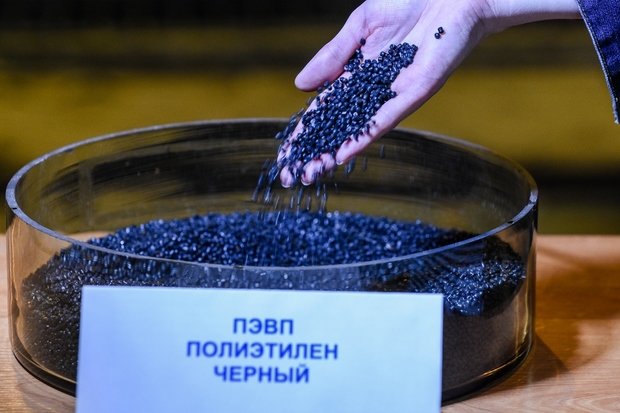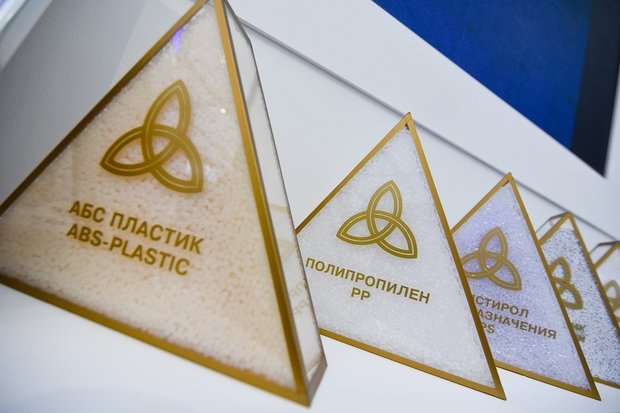NKNKH: ''We increased the demand of linear low-density polyethylene among Russian enterprises by almost 6%''
In 2017, Nizhnekamskneftekhim increased linear low-density polyethylene production by 70%, thus smashing its own target. Thanks to this, LLDPE imports reduced by 55,000 tonnes. Director of the Polymer Promotion Administration at NKNKH and Director of Advertising and Exhibition Department Marat Fatykhov told Realnoe Vremya online newspaper how difficult it was to drive foreign players out of the Russian market and what government support enterprises needed for successful import substitution.
LLDPE imports reduced by 55,000 tonnes in 2017
Mr Fatykhov, could you draw conclusions of plastic production in 2017? How did the share of plastics change in NKNKH's total revenue in 2017?
In 2017, the share of plastics in the total volume of production amounted to almost 38%. In monetary terms, it's more than one-third. The volume of plastic production grew by almost 2,500 tonnes mainly by increasing polystyrene production. We need to note that rubber production also grew in the enterprise in 2017. This is why the volume of plastic production in comparison with other types of products remains nearly at the same level in percentage terms.
Linear polyethylene production was to increase by 50% in 2017. Where was the big volume of commodity supplied to?
Yes, indeed, we planned to increase linear low-density polyethylene (LLDPE) production by 50%. However, we went further, and the increase was more than 70%. Now we keep on augmenting the production of this type of polyethylene to 160,000 tonnes.
Speaking about the Russian consumption market of those LLDPE types that we could substitute, by our estimate, it's about 180-190,000 tonnes a year. What did our actions lead to? Firstly, LLDPE imports reduced by 55,000 tonnes in 2017. The most interesting thing is that we increased the demand of linear low-density polyethylene among Russian enterprises by almost 6%, though there wasn't growth in polyethylene consumption, including high-density polyethylene (НDPE). This means we managed to give an impetus to develop linear low-density polyethylene conversion because our product became more available for the consumer. But, as it's known, the further you go, the harder it is. If it was quite easy to agree on this polyethylene supply with big market players at the initial stage of import substitution, now work is becoming complicated. A part of consumers doesn't want to depend on one supplier, others doubt timely supplies or the quality of our polyethylene. And there are those who simply prefer to work with a foreign company for non-commercial reason. This is why our task is to prove our product is more available. And the quality not only doesn't lose to foreign analogues but also excels them. I think specialists of the commercial service of Nizhnekamskneftekhim cope with this uneasy task.
The share of high-density polyethylene in the total commodity volume of NKNKH reduced from 70 to 16% from 2013 to 2017, while the share of linear low-density polyethylene grew from 8 to 69%. How is such a situation explained?
The case is that we have one technological line to produce low-density polyethylene. This is why augmenting production of one product, the production of another one reduces naturally. We try to optimise the production structure as much as possible to meet market requirements. Our country has four low-density polyethylene (LDPE) producers with a total production volume of more than a million tonnes of polyethylene, including high-density polyethylene and linear low-density polyethylene. Our market doesn't have LLDPE except that of Nizhnekamsk. For this reason, our task is to be there where there is an acute shortage of the Russian product.

Last year, NKNKH had new types of polystyrene, polyethylene and polypropylene. What's their distinctive feature?
Entering a market with a new product or so-called 'homologation' of a product is always a complicated and long process. It takes time not only for scientific development but also, most importantly, an informed decision on the necessity to master the production technology directly on the technological line. In addition, the converter needs to test the new type. And here everything not always turns on us. The converter, who is really interested in the new type, does its own research fast. But there also problems not linked with the technology. This is why, as I already said, we often have to prove it's more comfortable to work with us, and our product has a better quality.
For instance, so-called butene polyethylene, in whose production only 1-butene is used as co-monomer, has just recently accounted for the major volume of foreign linear low-density polyethylene. In our technology, together with 1-butene, we use a considerable amount of 1-hexene with a longer molecular chain. This is why thanks to stronger intermolecular interactions, we get polyethylene used to make a more durable film with improved optical characteristics. There are many examples of this kind. The same thing can be said about polyethylene for rotational moulding. Unlike the majority of foreign analogues, our polyethylene for this type of conversion is completely based on hexane. Consequently, it's more durable, which is very important while making large-sized articles.
''The high demand for our polypropylene is the best evidence of high quality''
How complicated is it to compete with foreign producers in the plastics market?
I often have to answer this question at meetings with our new partners who know little about us. The case is that our plastics are made with the best world technologies of famous brands including LyondellBasell, Toyo Engineering, Total Petrochemical and Versailles. I often visited foreign units and need to say the production culture in our enterprise is even higher than in foreign companies. I've already said a lot about the quality of polyethylene. I will add the uniqueness of the brand assortment of polyethylene with pleasure: we produce about 70% of Russian co-polymers of propylene with ethylene. It's so-called block co-polymers and statistical co-polymers (random), which we make in a wide assortment and for different areas of application. And co-polymers in Russia are in surplus, our 'complex' types are always in demand, and even their deficit is felt. The high demand for our polypropylene is the best evidence of high quality. I think it's a big merit of Nizhnekamskneftekhim that there has been a rise in demand for co-polymers with ethylene in the last 5 years – almost 80,000 tonnes a year. However, supplies of foreign co-polymers haven't almost increased. Everybody knows that NKNKH has leading positions in the country in general purpose polystyrene (GPPS) and high impact polystyrene (HIPS) production. I especially want to note the wide brand assortment and high technological possibilities in polystyrene production in our enterprise. We can produce polystyrene with MFI from 2 to 30 for almost all areas of application on our technological lines – from extrusion to moulding.

The launch of new polyethylene production of SOCAR is expected in Azerbaijan this year, which will likely supply products to Russia. How do you think this will affect the demand for NKNKH's plastic?
We very carefully follow actions of our opponents. Yes, indeed, the launch of polypropylene and polyethylene production is expected in Azerbaijan. However, we hope the main volume of products will be sent to Turkey and Azerbaijan's neighbours – Kazakhstan, Kyrgyzstan, the Caucasus. We see how Uzbek polyethylene supplies grow. At the same time, we understand that it's high-density film polyethylene the competition with which we stopped by making linear low-density polyethylene. Of course, there will be competition with Azerbaijani polypropylene. But this only spurs us to produce what others don't make.
Could you estimate the import substitution programme at NKNKH?
Import substitution is a concept that causes an ambivalent attitude among people. There is such a concept as international integration. There are purely technological possibilities of units: it's impossible to make all types on one unit, and it's not necessary. Here questions of economic efficiency linked with increasing transition lots arise. For instance, why make the types whose consumption in the country is hundreds of tonnes a year? And we try to substitute foreign analogous where it's reasonable. I already said we substituted 55,000 tonnes of linear low-density polyethylene last year – it's a very big sum. In this issue, I think government support is needed in the form of import duties on those types of products (both feedstock or goods themselves) that are made in Russia. Why does Europe protect itself with these duties and invests the money it received in the budget in social programmes, while we behave in a much more modest way?
I also want to add that Nizhnekamskneftekhim PJSC mastered a new type of linear low-density polyethylene for blow moulding and lamination with a consumption volume in Russia equal to 20,000 tonnes a year. Only foreign feedstock was used before. We've made more than 7,000 tonnes of this type since then and hit the target. The major consumers confirmed the high quality – Danaflex, Artplast, Tiko-Plastic and others. We increase the presence in polyethylene for rotational moulding: we're already covering about 30% of consumption of such polyethylene in whose segment foreign brands have always stolen the show. In December 2017, there was the first development of РЕ6147К polyethylene to coat a power cable, which is different from previous analogous with an increased content of soot, high density and durability. We're the most integrated polypropylene manufacturing in the automotive industry because we manufacture block co-polymers with the increased content of ethylene, it means high shock- and frost-proof characteristics, which is needed for the automotive industry. Following our food packaging manufacturing partners' request, we started to master polystyrene with a lower content of residual styrene.
Partnership material